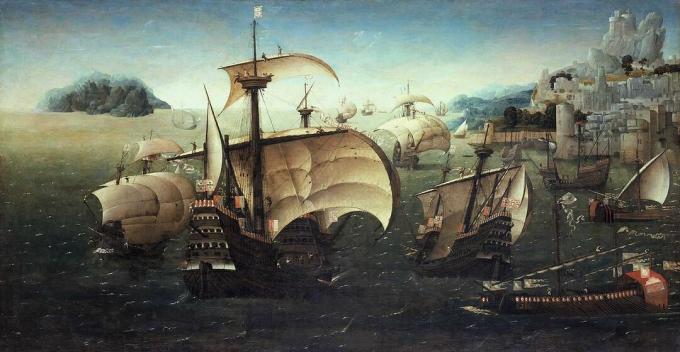Commercial capitalism, also called mercantile capitalism or mercantilism, was the first phase of the capitalist system. It begins at the end of the 15th century, with the decay of feudalism, and ends in the 18th century, with the strengthening of industrialization.
Also known as the pre-capitalist phase, commercial capitalism originated with the rise of National States and marks the end of the Middle Ages and the beginning of the Modern Age.
Capitalism is an economic system that seeks to accumulation of wealth. At that stage, the accumulation of capital was the result of trade exchanges - the main economic activity in Europe at that time.
Commercial capitalism has as its main characteristics the protectionism, O state control of the economy, O metalism and the favorable trade balance.
The next phases of this economic system are industrial capitalism and financial capitalism - the current phase of the system.
Emergence of commercial capitalism
Before the beginning of commercial capitalism, the current production system in Europe was feudal. O
feudalism it was a form of social, political, economic and cultural organization that was based on land ownership.It was a society of estates, formed by the nobility, fur clergy and hair servants and there was no social mobility. That is, it was not possible for a person to change from one social stratum to another.
The nobility was formed by feudal lords, the clergy was composed of members of the Catholic Church and the serfs were the workers, who received food and a place to live in exchange for work on the land of the masters, but did not receive wage.
The feudal economy was self-sufficient and all production was destined for local consumption.
However, with the growth of cities and maritime development, commercial activities and open markets began - spaces where people took their products to be sold.
With the intensification of trade, merchants - who represented the bourgeois class - began to accumulate capital. Capital became the source of wealth in this society, replacing land in feudalism.
Learn more about feudalism and understand the meaning of economy capital.
What was commercial capitalism?
One of the main changes marking the end of feudalism and the beginning of commercial capitalism is the relationship between labor and capital. Instead of the servile relationship of the manors, the free and paid work.
This is also the time for great navigations, when Europeans discover and colonize lands on the African and American continents. This colonization was largely due to the exploitation of natural and human resources for the benefit of the metropolis.
 Portuguese vessels at the end of the 15th century.
Portuguese vessels at the end of the 15th century.
In general, what happened in these colonies was the exploration and sending of raw material from the colony to the metropolis, which produced and sold more expensive goods and with that, accumulated capital. Many of these goods were purchased by the colony itself, guaranteeing the metropolis substantial profits.
The accumulation of wealth was, therefore, obtained through commercial exchanges and consequent obtaining of precious metals.
At that time, a nation's wealth was measured by the amount of precious metals accumulated. Hence the incessant search of Europeans for these metals in their colonies - in this period, huge amounts of silver and gold were withdrawn from the American continent.
O slave trade and trade it was also a very profitable type of business for the colonizing countries during this period.
Commercial capitalism was an important phase for the development of capitalism in the centuries following, as it allowed the accumulation of capital that made possible, later on, the Revolution Industrial.
Read more about the mercantilism, capitalism and Industrial Revolution.
Main characteristics of commercial capitalism
- State control over the economy: mercantilism was marked by strong state intervention in the economy. Absolutist states controlled the markets and determined the amount of taxes.
- Protectionism: customs duties and taxes protected the entry of imported products into countries, with the aim of protecting national industries and manufactures.
- Metalism: a country's wealth was determined by the accumulated amount of precious metal (gold and silver). Much of these metals were removed from the colonies and sent to the metropolises during this period.
- Favorable Trade Balance: countries struggled to make their exports surpass their imports so that the country's financial situation remained positive.
International division of labor in commercial capitalism
An important concept that explains the world productive organization from that period onwards is the international division of labor. According to this theory, each part of the world plays a certain role in the global productive organization.
During mercantilism, the international division of colonial labor prevailed, represented by the division between colony and metropolis. In this scheme, the colony offered spices, precious metals and raw materials to the metropolis, which produced manufactured goods.
See also the following phases of the capitalist system: industrial capitalism and financial capitalism.
